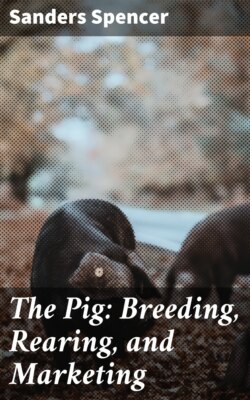Читать книгу The Pig: Breeding, Rearing, and Marketing - Spencer Sanders - Страница 13
На сайте Литреса книга снята с продажи.
LARGE WHITE
ОглавлениеColour.—White, free from black hairs, and as free as possible from blue spots on the skin.
Head.—Moderately long, face slightly dished, snout broad, not too much turned up, jowl not too heavy, wide between the ears.
Ears.—Long, thin, slightly inclined forward, and fringed with fine hair.
Neck.—Long, and proportionately full to shoulders.
Chest.—Wide and deep.
Shoulders.—Level across the top, not too wide, free from coarseness.
Legs.—Straight and well set, level with the outside of the body with flat bone.
Pasterns.—Short and springy.
Feet.—Strong, even, and wide.
Back.—Long, level, and wide from neck to rump.
Loin.—Broad.
Tail.—Set high, stout and long, but not coarse, with tassel of fine hair.
Sides.—Deep.
Ribs.—Well sprung.
Belly.—Full, but not flabby, with straight under line.
Flank.—Thick, and well let down.
Quarters.—Long and wide.
Hams.—Broad, full, and deep to hocks.
Coat.—Long and moderately fine.
Action.—Firm and free.
Skin.—Not too thick, quite free from wrinkles. Large bred pigs do not fully develop their points until some months old, the pig at five months often proving at a year or 15 months a much better animal than could be anticipated at the earlier age and vice versâ; but size and quality are most important.
Objections.—Black hairs, black spots, a curly coat, a coarse mane, short snout, inbent knees, hollowness at back of shoulders.
